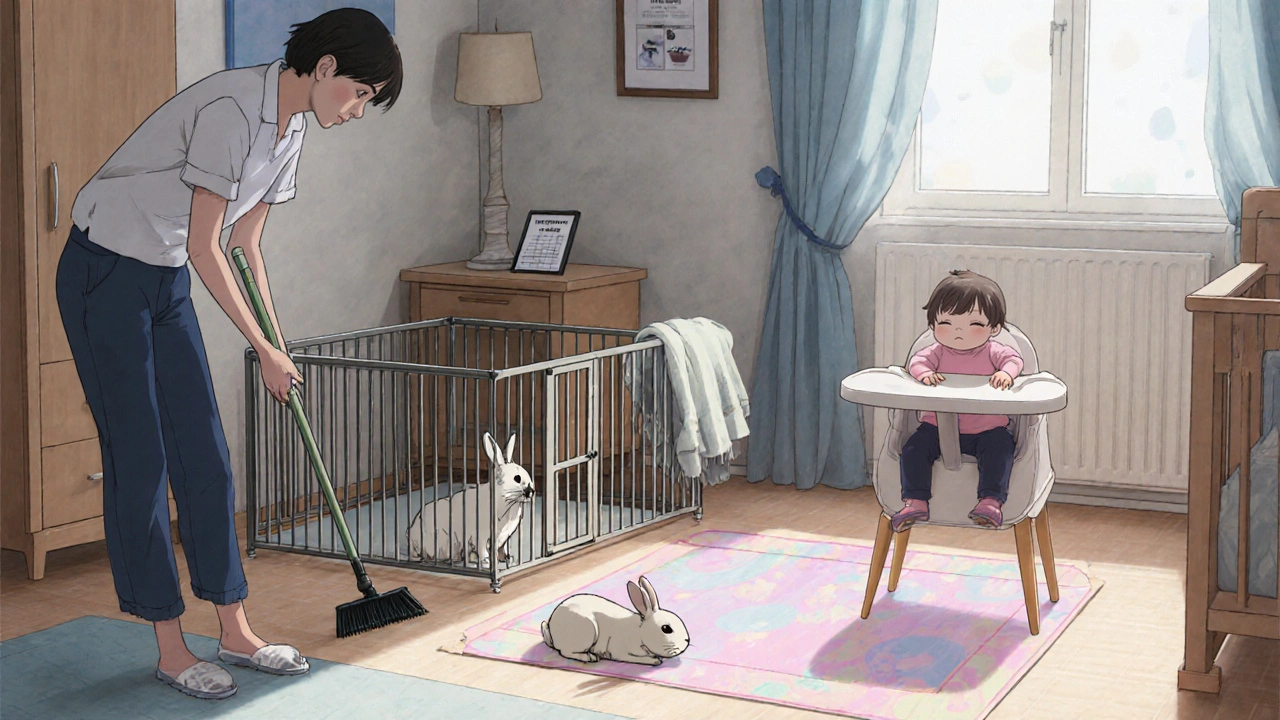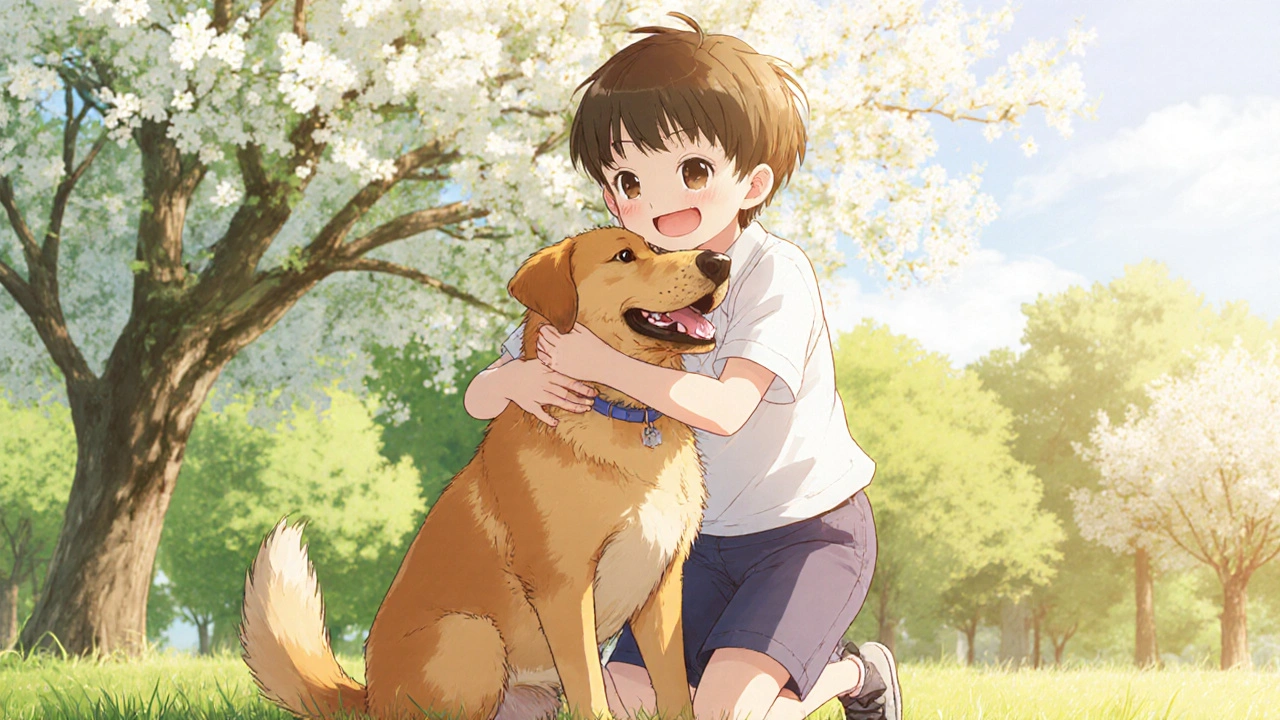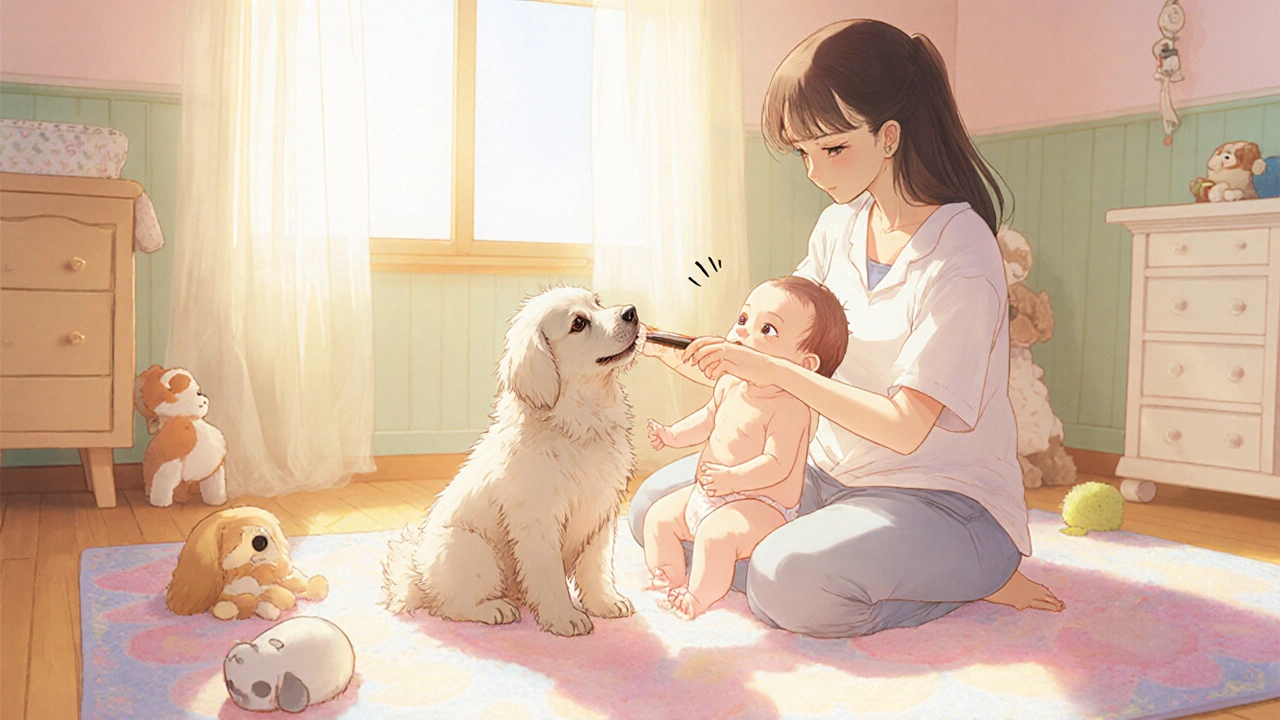Pet Suitability Calculator
Assess Your Pet's Fit for Infant Interaction
Based on your pet's characteristics and home environment, we'll calculate a suitability score for safe infant interaction.
Good Compatibility
Your pet shows strong potential for safe infant interaction.
Key Takeaways
- Pets can boost early empathy and social skills when introduced safely.
- Choosing the right pet and preparing the home reduces health risks.
- Simple daily routines help infants bond with their animal companions.
- Watch for signs of stress in both baby and pet to keep interactions positive.
- Professional guidance-from pediatricians and veterinarians-ensures a happy, healthy partnership.
When families consider Pets as companions that can interact with newborns and toddlers, they often wonder about the impact on early childhood development. Recent research shows that gentle, supervised contact with a Pet can spark Empathy development long before a child can speak. The goal of this guide is to show how parents can turn a pet into a trustworthy sidekick for their infant, while keeping safety and health front‑and‑center.
Why Early Pet Interaction Matters
During Infancy (birth to 12 months), the brain is a sponge, wiring connections for language, motor skills, and social awareness. Studies from the University of Washington tracked 200 families over two years and found that infants who regularly observed calm, caring interactions between a caregiver and a dog showed a 15% increase in later prosocial behavior scores. The reason is simple: watching a pet respond to human emotions gives the baby a live model of caring, which later translates into empathic actions toward peers.
Choosing the Right Pet for an Infant Home
Not every animal fits a household with a newborn. Here’s a quick look at the most common choices:
| Pet | Typical Size & Space Needs | Allergy Risk | Temperament for Babies |
|---|---|---|---|
| Dog (small‑to‑medium) | Needs daily walks, indoor space | Medium - dander can trigger | Generally protective, trainable |
| Cat | Indoor‑friendly, low space | High - strong dander | Independent, may tolerate gentle touch |
| Rabbit | Enclosed pen, quiet | Low - less dander | Gentle, but easily stressed |
| Guinea pig | Small cage, minimal space | Low - minimal shedding | Calm, likes handling |
Dogs often emerge as the top pick for families seeking active companionship, while low‑allergy options like rabbits or guinea pigs fit apartments with tighter space constraints. The choice should align with the family’s lifestyle, allergy sensitivities, and willingness to invest time in training.

Preparing Your Home and Pet for Safe Interactions
Before the first cuddle, follow these three steps:
- Schedule a Veterinary health check to confirm vaccinations are up‑to‑date and parasites are cleared. A clean pet reduces the risk of Allergic reactions or infections for the infant.
- Teach the pet a "gentle" cue. Reward calm behavior with treats and praise. Consistency turns a playful dog into a mindful guardian.
- Set up a pet‑free zone (often the crib area) where the baby can retreat if the animal gets too curious.
These basics create a predictable environment, which is crucial for both infant and animal confidence.
Building Empathy Through Simple Daily Routines
Even a 5‑minute “pet‑time” can lay the groundwork for empathy. Try these activities:
- Observation session: Hold your baby on a lap and let them watch you gently brush the pet. Narrate the action-"We’re brushing Max because he’s a friend"-so the infant links caring words with the animal’s response.
- Touch exchange: When the pet is calm, let the baby’s hand rest lightly on the fur. The pet’s relaxed sigh signals a positive outcome, reinforcing the baby’s sense that their touch can make the animal feel good.
- Storytime with the pet: Read a short picture book about animals while the pet lies nearby. Repeating animal names builds vocabulary and solidifies the pet as part of the family narrative.
These routines tap into Attachment theory, which says that secure early bonds-whether with people or gentle animals-form a template for later relationships.
Spotting Early Signs of Positive Impact
Parents often ask, "How do I know it’s working?" Look for these cues:
- Smiles or cooing when the pet approaches.
- Increased eye contact with both caregiver and animal.
- Calm demeanor during pet interaction compared to other stimuli.
If a baby shows distress-crying, turning away, or stiffening-step back and reassess the setting. The goal is a pleasant experience for both sides.

Managing Risks: Health and Behavioral Concerns
Even the friendliest pet can pose challenges. Here’s a quick risk‑mitigation checklist:
- Allergic reactions: Keep the pet’s bedding separate from the infant’s crib, and vacuum frequently to reduce dander.
- Scratches or bites: Never leave a pet unsupervised with a baby. Teach gentle play from day one.
- Hygiene: Wash hands after handling the pet, especially before feeding or changing the baby.
- Stress signals: A pet that growls, snaps, or hides may be overstimulated. Provide a quiet retreat and limit exposure time.
When in doubt, consult a pediatrician familiar with Animal‑assisted therapy guidelines. Professionals can suggest tailored interaction plans based on your child’s temperament.
Long‑Term Benefits: From Empathy to Social Success
Researchers at the University of Chicago followed children who grew up with a family dog from age 1 to 10. Those kids scored 12% higher on standardized empathy assessments and were less likely to exhibit bullying behaviors in school. The early exposure to a responsive animal appears to give children a head start in recognizing emotions and offering help.
This advantage isn’t limited to dogs. Cats, rabbits, and even fish can spark curiosity about living beings, prompting kids to ask "why" and "how"-the foundation of scientific inquiry and compassionate citizenship.
Frequently Asked Questions
Can a newborn safely be around a pet?
Yes, as long as the pet is healthy, vaccinated, and the interaction is always supervised. Begin with short, calm observations and gradually increase contact.
What is the best type of pet for a family with an infant?
Small‑to‑medium dogs and calm cats are popular choices, but low‑allergy small mammals like rabbits or guinea pigs work well in tighter spaces. Consider lifestyle, allergies, and time commitment.
How often should a baby interact with a pet?
Start with 5‑10 minute sessions a few times a week, always under adult supervision. Watch for cues of comfort or stress, and adjust duration accordingly.
What signs indicate my baby is developing empathy through pet interaction?
Look for smiling, cooing, or gentle touching of the animal, as well as increased eye contact. These behaviors suggest the child is recognizing and responding to the pet’s emotional state.
Should I get a professional assessment before introducing a pet?
A brief consult with a pediatrician and a veterinarian can identify any health or behavioral concerns early, ensuring a smoother bonding process.
Bringing a pet into the early years of a child's life can be a rewarding journey. By choosing the right animal, preparing the environment, and nurturing gentle, consistent interactions, families set the stage for empathy, companionship, and lifelong emotional health. Remember, the magic happens when both baby and pet feel safe, loved, and respected.



Jay Kay
October 19, 2025 AT 20:53Pets are like tiny teachers for babies.
Without proper supervision you could end up with a mess.
Jameson The Owl
October 20, 2025 AT 19:06The concept of early animal interaction is not a recent fad.
It is rooted in decades of developmental research.
Studies show that infants observe caregiver‑pet dynamics.
These observations translate into neural pathways for empathy.
The data from University of Washington supports a measurable increase in prosocial scores.
Parents often underestimate the importance of consistent routine.
Setting a calm environment reduces stress for both child and animal.
A vaccinated and parasite‑free pet lowers health risks.
Training a simple “gentle” cue creates predictable behavior.
Supervision at all times prevents accidental bites.
Allergy management includes regular vacuuming and separate bedding.
Professional guidance from pediatricians and veterinarians is advisable.
Long term benefits include higher empathy assessments in school.
Early exposure also correlates with better emotional regulation.
The evidence is compelling and warrants serious consideration.
Implementing these steps can transform a household into a nurturing community.
Rakhi Kasana
October 21, 2025 AT 17:20Watching a calm dog snuggle a caregiver can spark a baby’s curiosity.
The tiny coo when the puppy rolls over is pure gold for early bonding.
Sunil Yathakula
October 22, 2025 AT 15:33hey fam, i love how you’re thinking about safety first.
just a tip – keep the pet’s toys away from the crib so the baby doesn’t grab anything sharp.
also, wash your hands after patting the bunny before you hold the baby – it’s a tiny step that makes a big difference.
Catherine Viola
October 23, 2025 AT 13:46While the article presents a polished overview, it omits discussion of the hidden agendas driving the pet industry.
Manufacturers of hypoallergenic breeds often fund research that shows minimal risk, thereby shaping public policy.
Consult independent veterinary sources and request raw data before making a commitment.
sravya rudraraju
October 24, 2025 AT 12:00Dear readers, the integration of a companion animal into an infant’s daily routine can be approached methodically.
Begin by establishing a predictable schedule that aligns feeding times for both the child and the pet, thereby reinforcing a sense of order.
Next, incorporate brief observation periods where the caregiver narrates the pet’s actions, which serves to build the infant’s vocabulary in a contextual manner.
Such intentional practices not only nurture empathy but also promote cognitive development through associative learning.
Additionally, fostering an inclusive environment where all family members, including the pet, feel valued, strengthens relational bonds that endure into later childhood.
By adhering to these evidence‑based strategies, families can cultivate a harmonious household that supports both emotional and social growth.
Ben Bathgate
October 25, 2025 AT 10:13Honestly, if you’re not ready to clean up fur and occasional messes, maybe skip the pet until the kid is older.
Ankitpgujjar Poswal
October 26, 2025 AT 07:26Listen, you’ve got this! Train the dog to sit and stay before you even bring the baby home – that discipline will pay off when the little one starts crawling.
Christopher Burczyk
October 27, 2025 AT 05:40Empirical evidence suggests that early exposure to domesticated animals correlates with statistically significant improvements in empathy metrics, as documented in peer‑reviewed journals.
Caroline Keller
October 28, 2025 AT 03:53It is utterly heartbreaking to see people ignore the emotional toll on both child and animal.
We must demand that every household implements these safeguards immediately.
Otherwise we are complicit in creating needless distress.
dennis turcios
October 29, 2025 AT 02:06While the guidelines are useful, remember each family dynamic is unique.
Adjust interaction times based on your baby’s reactions and your pet’s temperament.
Felix Chan
October 30, 2025 AT 00:20Go for it and enjoy the cuddles!